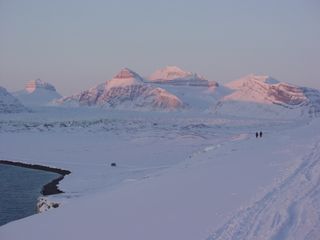Arctic Glacier Has Its Own Aquifer

Isolated glaciers can store liquid water in their upper layers year-round, a new study finds.
The discovery means that the Greenland ice sheet isn't the only icy spot on Earth where snow and ice can hoard meltwater for years.
"I do think they will be found in more glaciers that have similar processes at work," said lead study author Knut Christianson, a University of Washington glaciologist.
In recent years, researchers have discovered that certain parts of the Greenland Ice Sheet hold extensive liquid water. These water reservoirs are called "firn" aquifers because the water is stored in the firn, which are the older layers of snow that didn't melt in previous years, and where old snow eventually compacts into ice.
The water is trapped in small spaces between snow particles, like the juice in a snow cone.
Now, researchers from the University of Washington and the Norwegian Polar Institute have discovered a similar firn aquifer in Norway's Holtedahlfonna glacier, in the Svalbard islands. Holtedahlfonna is about 31 miles (50 kilometers) long and covers about 150 square miles (390 square km). [Ice World: Gallery of Awe-Inspiring Glaciers]
The aquifer was discovered more than 20 years ago by Japanese scientists, who reportedly recovered an ice core from within the glacier that was dripping wet with water, Christianson told Live Science. However, summer aquifers are common on isolated glaciers, and so the water wasn't considered unusual, he said. "Aquifers on mountain glaciers have been known since the 1970s, but they are thought to drain every summer," Christianson said.
Sign up for the Live Science daily newsletter now
Get the world’s most fascinating discoveries delivered straight to your inbox.
But surveys on the glacier during freezing winter temperatures, a decade later, also found liquid water, which was worth a closer look.
Christianson and his colleagues mapped the aquifer with a combination of ground radar and GPS between 2003 and 2007. Water returns a "brighter" signal in the radar data than ice does.
The researchers found water that lasted through several winters, and the team watched the top of the aquifer rise during warm summers (meaning there was more water) and fall during winter, when the water drained, the researchers reported Feb. 17 in the journal Geophysical Research Letters. The water level also dropped by up to 11.5 feet (3.5 meters) between 2005 and 2007.
Firn aquifers form in regions where there is both a lot of snow accumulation and summer melting. The layer of liquid water that percolates into the firn survives freezing winter temperatures because it is insulated by the thick snow. But if winter temperatures are too cold, snowfall is too sparse or there is too much meltwater, the firn will freeze solid.
The Holtedahlfonna aquifer is only 33 to 66 feet (10 to 20 m) thick and doesn't have the potential to raise global sea level, the researchers said. However, studying this aquifer, and undiscovered aquifers at similar glaciers, could offer new insights into how glaciers store meltwater, Christianson said. And compared to the Greenland ice sheet, some of those other glaciers may also be easier to get to, he said.
"It would be really nice to build our understanding at a smaller system, and take that to Greenland," he said.
In Greenland, scientists are now investigating whether the ice sheet aquifers are likely to grow larger with global warming. The huge extent of the aquifers in Greenland means the water stored inside the glaciers there could potentially offset sea level rise, Christianson said.
The aquifers took up some of the huge amounts of meltwater produced by the island's extreme 2012 surface melt, according to preliminary results by other scientists. Researchers who study how glaciers move are also watching to see if water escaping the aquifers could lubricate glaciers and increase ice loss — a faster-moving glacier drops more ice into the ocean.
Follow Becky Oskin @beckyoskin. Follow Live Science @livescience, Facebook & Google+. Originally published on Live Science.

Most Popular

